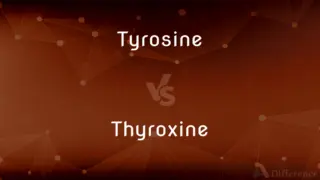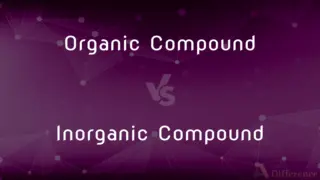Acrylamide vs. Polyacrylamide — What's the Difference?
By Tayyaba Rehman & Urooj Arif — Updated on May 10, 2024
Acrylamide is a toxic monomer used in industrial and scientific applications, while polyacrylamide is a polymer formed from acrylamide subunits, used primarily to stabilize and thicken substances.

Difference Between Acrylamide and Polyacrylamide
Table of Contents
ADVERTISEMENT
Key Differences
Acrylamide is a chemical compound known for its use in the production of polyacrylamide and various industrial processes such as the manufacture of paper, dyes, and plastics. Polyacrylamide, on the other hand, is a polymer derived from acrylamide units, widely used as a flocculant in wastewater treatment and as a gel in electrophoresis for the separation of proteins.
While acrylamide itself is hazardous and recognized as a potential carcinogen, polyacrylamide is considered non-toxic in its polymerized form but can potentially release acrylamide under certain conditions. Whereas acrylamide requires careful handling due to its toxicity, polyacrylamide is generally safer but still requires prudent use due to the possible degradation back to acrylamide.
Acrylamide is typically handled in industrial settings with strict safety measures to avoid inhalation or skin contact. Conversely, polyacrylamide is used in various applications from agriculture to pharmaceuticals, where its ability to form hydrogels is highly valued for slow-release substances.
In terms of environmental impact, acrylamide can pose serious hazards if released into ecosystems, affecting water quality and aquatic life. Polyacrylamide is often used to improve soil structure and reduce erosion but must be monitored for its breakdown products, including acrylamide, which are environmentally concerning.
Comparison Chart
Chemical Structure
Simple monomer
Long-chain polymer of repeating acrylamide units
ADVERTISEMENT
Uses
Production of plastics, dyes, paper
Water treatment, soil conditioner, electrophoresis gel
Toxicity
High (potential carcinogen)
Low (but can degrade into toxic acrylamide)
Handling
Requires strict safety measures
Safer to handle but precautions needed
Environmental Impact
Toxic to aquatic life if released
Used to reduce soil erosion; concerns over acrylamide release
Compare with Definitions
Acrylamide
Known for its neurotoxic effects and potential to cause cancer.
Workers handle acrylamide with care to avoid exposure risks.
Polyacrylamide
A polymer used as a flocculant in wastewater treatment.
They added polyacrylamide to the water to clarify it.
Acrylamide
A white, odorless, crystalline solid used primarily in industrial processes.
Acrylamide is crucial in the synthesis of polymeric materials.
Polyacrylamide
Considered safe in its polymer form but monitored for degradation products.
The environmental safety of polyacrylamide focuses on preventing breakdown.
Acrylamide
Can form in some starchy foods during high-temperature cooking.
Acrylamide is a concern in foods like French fries and potato chips.
Polyacrylamide
Employed in various applications, including drug delivery systems.
Polyacrylamide hydrogels slowly release medications in targeted therapy.
Acrylamide
Used in the production of polyacrylamide and other polymers.
The factory uses acrylamide as a starting material for various polymers.
Polyacrylamide
Forms a gel used in electrophoresis.
Scientists use polyacrylamide gels to separate proteins based on size.
Acrylamide
Regulated due to its hazardous nature.
Regulations ensure that acrylamide levels in water and food remain within safe limits.
Polyacrylamide
Helps in soil conditioning to prevent erosion.
Polyacrylamide is used in agriculture to improve water retention and soil structure.
Acrylamide
Acrylamide (or acrylic amide) is an organic compound with the chemical formula CH2=CHC(O)NH2. It is a white odorless solid, soluble in water and several organic solvents.
Polyacrylamide
Polyacrylamide (abbreviated as PAM) is a polymer with the formula (-CH2CHCONH2-). It has a linear-chain structure.
Acrylamide
A readily polymerized amide, C3H5NO, derived from acrylic acid and used in synthetic fibers and sewage treatment. It is a carcinogen and is present in some foods, especially starches and cereals that are cooked at high temperatures.
Polyacrylamide
A synthetic resin made by polymerizing acrylamide, especially a water-soluble polymer used to form or stabilize gels and as a thickening or clarifying agent
Polyacrylamide gels
Linear polyacrylamide is a very efficient neutral carrier
Acrylamide
(organic compound) The amide of acrylic acid, CH2=CH.CONH2; used in the manufacture of polyacrylamides.
Polyacrylamide
A water-soluble white solid polyamide, (-CH2CHCONH2-), related to acrylic acid.
Acrylamide
A white crystalline amide of propenoic acid can damage the nervous system and is carcinogenic in laboratory animals;
They claimed that acrylamide is produced when certain carbohydrates are baked or fried at high temperatures
Polyacrylamide
(organic compound) Any of a range of cross-linked polymers of acrylamide; used to form soft gels for making contact lenses etc.
Common Curiosities
What is acrylamide used for?
Acrylamide is used in the production of polymers and chemicals, and in laboratory settings as a precursor to polyacrylamide.
What are the safety measures for handling acrylamide?
Safety measures include using personal protective equipment, working in well-ventilated areas, and adhering to strict industrial hygiene practices.
Is acrylamide dangerous to humans?
Yes, acrylamide is classified as a probable human carcinogen and is known to cause neurological damage if inhaled or absorbed through the skin.
What role does polyacrylamide play in water treatment?
It acts as a flocculant, helping to clump together suspended particles, making them easier to remove from water.
How are acrylamide and polyacrylamide related?
Polyacrylamide is synthesized from acrylamide monomers, linking many acrylamide units together to form long polymer chains.
How is polyacrylamide used in environmental management?
Polyacrylamide is used as a flocculant in water treatment processes and as a soil stabilizer to prevent erosion.
Can polyacrylamide be toxic?
Polyacrylamide is generally considered non-toxic, but it can potentially release toxic acrylamide under certain conditions such as high temperature or over time.
How is polyacrylamide disposed of?
Polyacrylamide disposal must be handled according to local environmental regulations to prevent its breakdown products from contaminating the environment.
How does acrylamide form in food?
Acrylamide can form in foods during high-temperature cooking processes, such as frying, roasting, or baking, particularly in starchy foods.
Why is acrylamide regulated in food and water?
Due to its toxicological properties and potential health risks, acrylamide is regulated to ensure consumer safety in food products and to protect water quality.
Are there alternatives to acrylamide and polyacrylamide?
Researchers are exploring safer alternatives to acrylamide in industrial applications and more environmentally stable compounds that can replace polyacrylamide in specific uses.
What are the environmental impacts of acrylamide and polyacrylamide?
Acrylamide is toxic to aquatic life and can contaminate water sources, whereas polyacrylamide is used beneficially for soil and water treatment but must be monitored for potential acrylamide release.
How do regulations affect the use of acrylamide and polyacrylamide?
Regulations aim to limit exposure and manage risks associated with acrylamide in the workplace and in consumer products, while polyacrylamide use is regulated primarily in terms of environmental impact.
What are the health risks associated with polyacrylamide?
While polyacrylamide itself is not considered a major health risk, the presence of residual acrylamide monomers or its breakdown to acrylamide can pose health hazards.
What research is being done on acrylamide and polyacrylamide?
Ongoing research focuses on reducing acrylamide formation in foods, developing safer forms of polyacrylamide, and exploring their effects on health and the environment.
Share Your Discovery

Previous Comparison
Methodology vs. Approach
Next Comparison
Mahayana vs. HinayanaAuthor Spotlight
Written by
Tayyaba RehmanTayyaba Rehman is a distinguished writer, currently serving as a primary contributor to askdifference.com. As a researcher in semantics and etymology, Tayyaba's passion for the complexity of languages and their distinctions has found a perfect home on the platform. Tayyaba delves into the intricacies of language, distinguishing between commonly confused words and phrases, thereby providing clarity for readers worldwide.
Co-written by
Urooj ArifUrooj is a skilled content writer at Ask Difference, known for her exceptional ability to simplify complex topics into engaging and informative content. With a passion for research and a flair for clear, concise writing, she consistently delivers articles that resonate with our diverse audience.
















































